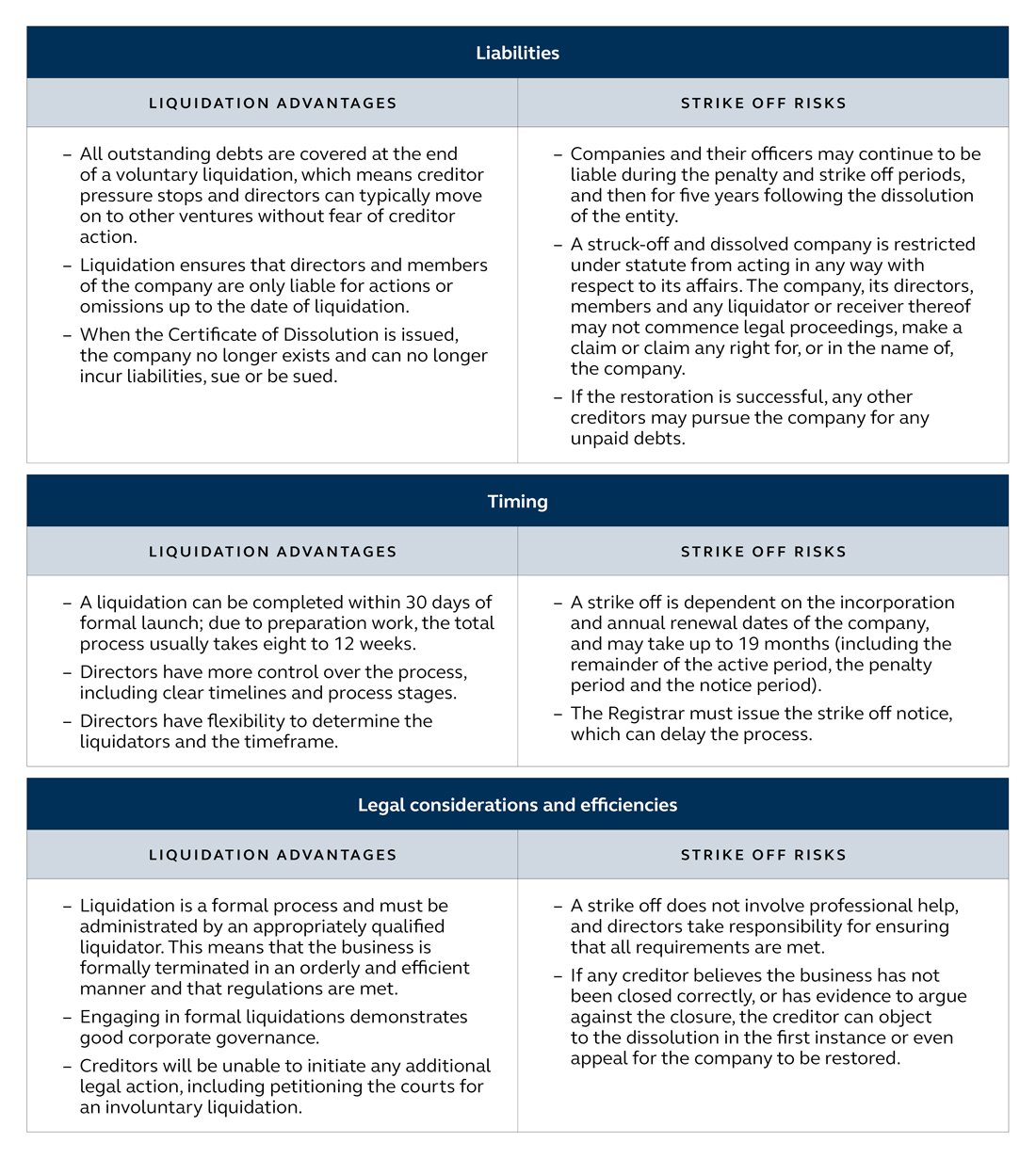I no longer need my BVI company: Strike off or liquidation?

There are several reasons an organisation might dissolve a BVI company. For example, the company may no longer be required for its originally intended purpose, or it may have been fully divested of all its assets and liabilities. In these circumstances, the company has various options, including:
- A strike off followed by dissolution, following non-payment of license fees;
- A request to the BVI Companies Registrar (the Registrar) to strike the company from the register; or
- A voluntary liquidation (provided the company is solvent, that is, that its assets exceed its liabilities or the company has no assets or liabilities).
A voluntary liquidation is the safest, most formal way to close a BVI company. Strike off and dissolution effected either voluntarily or by way of non-payment of license fees is not uncommon, but as we’ll see from the analysis below, this is not recommended in most situations.
Strike off and dissolution
Historically, a company which had been struck off the BVI register following non-payment of license fees would continue to exist in a suspended state for a period of seven years. During this time, the company would still technically be registered, but it would be unable to conduct business or defend itself against any action or lawsuits. After the seven-year period, the company would be dissolved automatically, as if it had been formally liquidated.
BVI authorities have revised the above process, removing the seven-year dissolution waiting period. Effective 1 January 2023, a company which has not paid its license fees by the due date may be struck off and dissolved following a Registry notice period of no more than 90 days.
Following a dissolution in the above manner (that is, due to non-payment of license fees) the company may only be reinstated in one of two ways:
- By application of any relevant interested party (that is, a director, member or creditor) within five years, provided the company was deemed actively trading at the time of its dissolution; or
- By way of court application in the event the company was deemed dormant at the time of its dissolution (within a period of five years).
It should be noted that any assets which a dissolved company maintained at the time of dissolution are at risk of being vested in the Crown authority (that is, the BVI state) if they were not distributed prior to dissolution. When this occurs, a formal application must be made to the BVI court within five years to ensure the company’s rights to the assets are restored.
Liquidation
A company may only be liquidated under the BVI’s new rules if it has no liabilities — or if it is able to pay its debts when they are due — and the value of its assets equals or exceeds its liabilities.
The liquidation process takes eight to 12 weeks on average. The liquidator must be an individual, resident in the BVI, qualified in terms of educational background and experience, independent from the company, over 18, not bankrupt and of sound mind.
Where a voluntary liquidation is proposed, the company must take the following steps:
- Its directors must make a declaration of solvency. (A director making a solvency declaration without reasonable grounds is liable to a fine of US$10,000 on summary conviction.)
- Its directors must approve a liquidation plan.
- Its members must appoint liquidator(s). (In limited circumstances the directors may appoint the liquidator.)
- It must give the liquidator accounting records and underlying documentation for the past five years.
The declaration of solvency, liquidation plan, and appointment of a liquidator must be filed with the Registry. The formal liquidation process starts when the notice of the liquidator’s appointment is filed.
The appointment of the liquidator must then be advertised in the BVI’s Official Gazette, in one other BVI national newspaper, and in a national newspaper in the main trading jurisdiction(s).
The liquidator then takes control and custody of the assets. Although the company directors remain in office, they cease to have any function or powers. That said, they may authorise the liquidator to carry on the business of the company or act as authorised by written instruction from the liquidator.
On completion of the voluntary liquidation, the liquidator files a statement that the liquidation is complete with the Registrar. A copy of the declaration of solvency, with the statement of the company’s assets and liabilities attached, must be kept at the registered agent’s office. The registered agent will keep the accounting records and underlying company documentation for five years after the liquidation is complete.
The Registrar then issues a certificate of dissolution. The dissolution of the company is effective from the certificate issue date.
Immediately following the issue of the certificate of dissolution, the liquidator must publish a notice in the BVI Official Gazette that the company has been struck off the register and dissolved.
Advantages of liquidation over strike off and dissolution

This is an updated version of a previously published article.
The contents of this article are intended for informational purposes only. The article should not be relied on as legal or other professional advice. Neither Vistra Group Holding S.A. nor any of its group companies, subsidiaries or affiliates accept responsibility for any loss occasioned by actions taken or refrained from as a result of reading or otherwise consuming this article. For details, read our Legal and Regulatory notice at: https://www.vistra.com/notices . Copyright © 2024 by Vistra Group Holdings SA. All Rights Reserved.





